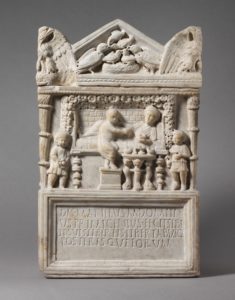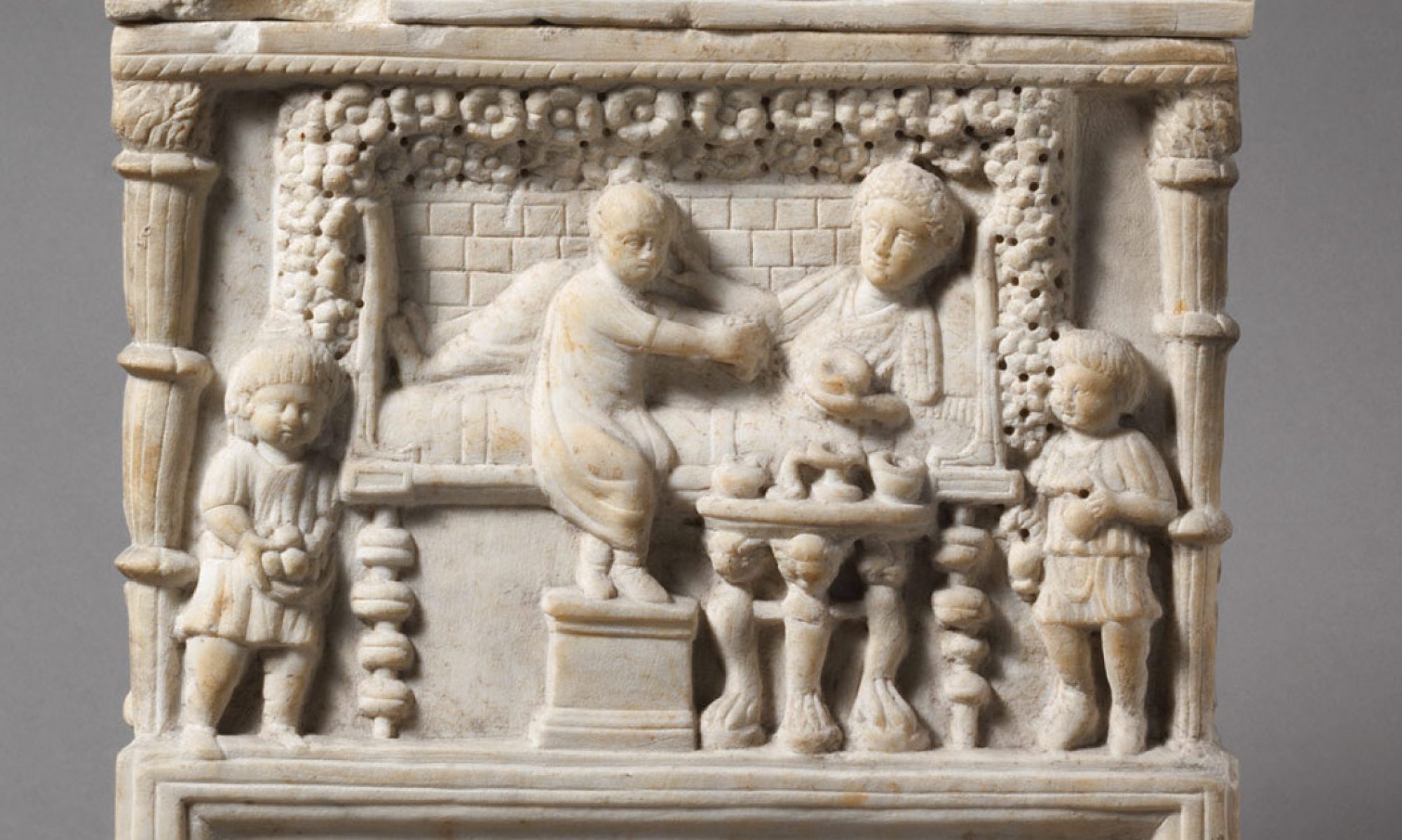
“To the spirits of the dead, Marcus Domitius
Primigenius made (this) for himself,
for his children, for his freedmen and freedwomen
and for their posterity”
Overview
Roman cinerary urns tell us unique stories of ancient Rome’s formerly enslaved people, new Roman citizens, the lower-middle class, and the relationships they shared with fellow Romans in the early imperial period. These modest marble monuments showcase the interests and merits of art made not merely as affordable mass-produced market products but as altars, gifts, and memorials. Their inscribed texts, too, highlight learning and linguistic variation that has been under appreciated in certain branches of philological studies until recently. Their range of forms, sculpted decoration, and inscribed names proffer a wealth of information that has previously been ignored or unrecognized by art historians, classicists, and humanists of many other fields too.
This project is a synthetic study of Roman imperial cinerary monuments, funerary urns, altars, and similar vessels made to hold cremated remains of Rome’s dead throughout the first century CE and into the second century. The focus of this project is investigating the production of a diverse corpus of sculpted marble cinerary urns and how their display in tombs influenced their making and appearance. Marble urns as a corpus, collectively called cineraria, are the only type of Roman urns to feature extensive decoration, and those carved as vases and chests are among the most prevalent to survive from antiquity. These striking urns demonstrate predominately the great artistic achievements and interests of Rome’s “low to middle class,” the numerous slaves, freedmen (liberti), those of uncertain status (incerti), and new Roman citizens born from formerly enslaved families (ingenui). Only recently (for the past twenty years) are these works of art coming to the fore in scholarship. As such, marble cineraria provide rare glimpses into the upward mobility of Rome’s lower classes and first generation citizens, but also who produced or paved the way for truly Roman art and how.
Background
Throughout the history of ancient Rome, both burial (inhumation) and cremation were the customary methods for disposing of the dead. In the early imperial period, cremation was the preferred method. Survivors of the deceased collected cremated remains (ossa or cinerēs) of their loved ones and deposited the combination of ash and bone in vessels typically identified as cinerary urns, ash altars, ash chests, or ossuaries.

These containers were produced in an array of sizes, materials (terra cotta, glass, alabaster, and granite), and in evocative forms (e.g., altars, chests, and vases) that were used by all strata of society in metropolitan Rome ranging from the enslaved to the emperor. While terra-cotta urns (called ollae) are the most abundant to survive from everyday people living in the imperial city, marble became the medium of choice for many individuals in Rome. Marble urns became emblematic for the corpus of cinerary vessels because of its ability to showcase the diverse aesthetic strategies sought by those people who could afford sculpted stone.
What they show
Let us consider the background image for this page, the cinerarium of Domitius Primigenius. Ornamental decoration, fruitful festoons, and motifs found in many other media adorn its composition, as with most chest-shaped marble cineraria. This decoration reflects the aesthetics popular among the whole urban population. Two flaming torches frame the scene and support the architectonic form of the urn. Playful figures surround or support framed inscription plaques, some of which were brightly rubricated with others left blank. Miniature portraits or figures body forth the presence of the deceased an peer out at the viewer from roundels or couches; others stand on display amid small scenes showcasing their virtue. Beside the funeral bier on our example, two vernae, enslaved children typically born in the household, attend the bier with Domitius Primigenius.
While many marble cineraria were more modest in scale but highly ornamental in decoration, certain larger, more imposing cineraria (typically of altar form) were more conservative in appearance with minimal decoration but more prominent inscription plaques. Inscriptions on cinerary urns, primarily in Latin but some Greek, present much of what we might call demographic data about the people who made and used the objects. Linguistic variation, formulaic phrases, personal sentiment, and devotional beliefs, in addition to the carving practices of the engravers, are all preserved in the texts. Greater examination of the inscriptions on urns points to the need for comparative studies with other inscriptions preserved in CIL VI and broader classifications in the subfield of epigraphy. Moreover, technical analysis of how the engravers of inscriptions worked in relation to the sculpted object draws attention to related practices. This project seeks to reinstate the role of letter engravers and stone-cutters into the field of sculpture rather than characterizing their skillets as limited rather than multi-faceted.
No matter the decorative component, however, whoever looks at marble cineraria, like the ancient viewers at the graves, gaze fondly at these monuments taken in by the solemn, intimate interaction established by the sculpted presence of the deceased, whether that be in name only or elaborated by a portrait-like figure.
Changes
By the second century, cultural preferences shifted with cremation declining in practice and cinerary urns rapidly decreasing in use; larger, typically more ornate marble sarcophagi for unburnt inhumed bodies became the preferred funerary vessels/monuments. In modern scholarship, sarcophagi have garnered the most attention because of their dynamic figural scenes, use of larger portraits, and ostensibly wealthier patrons. Marble cinerary urns, overlooked and understudied in scholarship on funerary art, and particularly the art of slaves, freedmen, and Rome’s middle class, remain valuable for greater study because they functioned simultaneously as practical containers, ritual objects, and stand-alone monuments that preserved the cremated remains of the deceased and commemorated their social identities after death. These marble works of art continued serving as important devotional objects for the living who maintained a funerary cult for their deceased loved ones.
Moving forward
For art historians, the relief decoration on marble cineraria is exceptional for its rich imagery and so-called “plebeian style,” but also for technical details of the sculpting (i.e., tool marks) that are detectable upon close examination. These tool marks and the varying states of completed carving reveal significant information about the objects and their production as well as the sculptors or stone-workers who made them. Combined with the epigraphic information from inscriptions on these urns, it is possible to examine and reconstruct the production of marble cineraria in a broad sense and establish relationships among different urns with similar marble sculpture, particularly funerary altars, reliefs, and small sarcophagi. This ScholarBlog is a work in-progress that presents ongoing research on the production of marble cinerary urns from metropolitan Rome and detailed analyses of their relief decoration.
By first looking closely at the surfaces of marble cinerary urns through technical analysis and considering the data they provide art historians, it is possible to start reevaluating their production and the influences of different display contexts. Continue >>
Research and travel for this project has been sponsored by the following:
The Emory Graduate Diversity Fellowship, the Laney Graduate School Professional Development Support Funds, the Fox Center for Humanistic Inquiry (PhD Interventions Project), the Andrew W. Mellon Foundation funds administered by the Art History Department in partnership with the Michael C. Carlos Museum and High Museum of Art, and Sir John Soane’s Museum Foundation.
